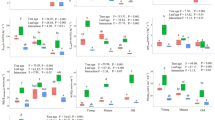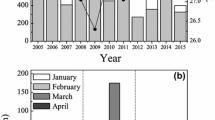Abstract
Leaf nitrogen content per area (Narea) is a good indicator of assimilative capacity of leaves of deciduous broad-leaved trees. This study examined the degrees of increase in Narea in response to canopy openings as leaf mass per area (LMA) and leaf nitrogen content per mass (Nmass) in saplings of eight deciduous broad-leaved tree species in Hokkaido, northern Japan. Five of the species were well-branched species with a large number of small leaves (lateral-growth type), and the other three species were less-branched species with a small number of large leaves (vertical-growth type). The degrees of increase in Narea were compared between the two crown types. In closed-canopy conditions, leaves of the vertical-growth species tended to have a lower LMA and higher Nmass than those of the lateral-growth species, which resulted in similar Narea for both. LMA increased in canopy openings in the eight species, and the degrees of increase were not largely different between the lateral- and vertical-growth species. On the contrary, Nmass was unchanged in canopy openings in the eight species. As a result, Narea of each species increased in canopy openings in proportion to the increase in LMA, and the degrees of increase in Narea were similar in the lateral- and vertical-growth species. Therefore, this study showed that the degrees of increase in Narea were not correlated with the crown architecture (i.e., the lateral- and vertical-growth types).



Similar content being viewed by others
References
Aerts R, De Caluwe H (1994) Effects of nitrogen supply on canopy structure and leaf nitrogen distribution in Carex species. Ecology 75:1482–1490
Bazzaz FA, Carlson RW (1982) Photosynthetic acclimation to variability in the light environment of early and late successional plants. Oecologia 54:313–316
Beaudet M, Messier C, Hilbert DW, Lo E, Wang ZM, Lechowicz MJ (2000) Leaf- and plant-level carbon gain in yellow birch, sugar maple, and beech seedlings from contrasting forest light environments. Can J For Res 30:390–404
Canham CD (1988) Growth and canopy architecture of shade-tolerant trees: response to canopy gaps. Ecology 69:786–795
Ellsworth DS, Reich PB (1992) Leaf mass per area, nitrogen content and photosynthetic carbon gain in Acer saccharum seedlings in contrasting forest light environments. Funct Ecol 6:423–435
Ellsworth DS, Reich PB (1993) Canopy structure and vertical patterns of photosynthesis and related leaf traits in a deciduous forest. Oecologia 96:169–178
Gould KS (1993) Leaf heteroblasty in Pseudopanax crassifolius: functional significance of leaf morphology and anatomy. Ann Bot 71:61–70
Hirose T, Werger MJA (1987) Nitrogen use efficiency in instantaneous and daily photosynthesis of leaves in the canopy of a Solidago altissima stand. Physiol Plant 70:215–222
Hiura T, Fujito E, Ishii T, Naniwa A, Sugata S, Ishida K, Murakami M, Kato E, Maeno H, Fukushima Y, Sakai T (1998) Stand structure of a deciduous broad-leaved forest in Tomakomai Experimental Forest, based on a large-plot data (in Japanese). Res Bull Hokkaido Univ For 55:1–10
Jurik TW (1986) Temporal and spatial patterns of specific leaf weight in successional northern hardwood tree species. Am J Bot 73:1083–1092
Kikuzawa K (1983) Leaf survival of woody plants in deciduous broad-leaved forests. I. Tall trees. Can J Bot 61:2133–2139
King DA (1991) Correlations between biomass allocation, relative growth rate and light environment in tropical forest saplings. Funct Ecol 5:485–492
King DA (1994) Influence of light level on the growth and morphology of saplings in a Panamanian forest. Am J Bot 81:948–957
Kitajima K (1994) Relative importance of photosynthetic traits and allocation patterns as correlates of seedling shade tolerance of 13 tropical trees. Oecologia 98:419–428
Kohyama T (1980) Growth pattern of Abies mariesii saplings under conditions of open-growth and suppression. Bot Mag Tokyo 93:13–24
Kohyama T (1987) Significance of architecture and allometry in saplings. Funct Ecol 1:399–404
Kohyama T (1991) A functional model describing sapling growth under a tropical forest canopy. Funct Ecol 5:83–90
Kohyama T, Hotta M (1990) Significance of allometry in tropical saplings. Funct Ecol 4:515–521
Koike T (1988) Leaf structure and photosynthetic performance as related to the forest succession of deciduous broad-leaved trees. Plant Species Biol 3:77–87
Kudo G (1995) Altitudinal effects on leaf traits and shoot growth of Betula platyphylla var. japonica. Can J For Res 25:1881–1885
Mladenoff DJ (1987) Dynamics of nitrogen mineralization and nitrification in hemlock and hardwood treefall gaps. Ecology 68:1171–1180
Muraoka H, Koizumi H, Pearcy RW (2003) Leaf display and photosynthesis of tree seedlings in a cool-temperate deciduous broadleaf forest understorey. Oecologia 135:500–509
Niinemets Ü (1996) Changes in foliage distribution with relative irradiance and tree size: difference between the saplings of Acer platanoides and Quercus robur. Ecol Res 11:269–281
Niinemets Ü (1997) Role of foliar nitrogen in light harvesting and shade tolerance of four temperate deciduous woody species. Funct Ecol 11:518–531
Niinemets Ü (1998) Growth of young trees of Acer platanoides and Quercus robur along a gap-understory continuum: interrelationships between allometry, biomass partitioning, nitrogen, and shade tolerance. Int J Plant Sci 159:318–330
Niinemets Ü, Kull O, Tenhunen JD (1999) Variability in leaf morphology and chemical composition as a function of canopy light environment in coexisting deciduous trees. Int J Plant Sci 160:837–848
Poorter L (2001) Light-dependent changes in biomass allocation and their importance for growth of rain forest tree species. Funct Ecol 15:113–123
Popma J, Bongers F (1988) The effect of canopy gaps on growth and morphology of seedlings of rain forest species. Oecologia 75:625–632
Reich PB, Walters MB, Ellsworth DS (1991a) Leaf age and season influence the relationships between leaf nitrogen, leaf mass per area and photosynthesis in maple and oak trees. Plant Cell Environ 14:251–259
Reich PB, Walters MB, Ellsworth DS (1991b) Leaf lifespan as a determinant of leaf structure and function among 23 Amazonian tree species. Oecologia 86:16–24
Reich PB, Walters MB, Ellsworth DS (1992) Leaf lifespan in relation to leaf, plant, and stand characteristics among diverse ecosystems. Ecol Monogr 62:365–392
Reich PB, Ellsworth DS, Walters MB (1998) Leaf structure (specific leaf area) modulates photosynthesis–nitrogen relations: evidence from within and across species and functional groups. Funct Ecol 12:948–958
Seino T (1998) Intermittent shoot growth in saplings of Acanthopanax sciadophylloides (Araliaceae). Ann Bot 81:535–543
Sokal RR, Rohlf FJ (1995) Biometry, 3rd edn. WH Freeman, New York
Sterck FJ (1999) Crown development in tropical rain forest trees in gaps and understorey. Plant Ecol 143:89–98
Takahashi K (1996) Plastic response of crown architecture to crowding in understorey trees of two co-dominating conifers. Ann Bot 77:159–164
Takahashi K, Yoshida K, Suzuki M, Seino T, Tani T, Tashiro N, Ishii T, Sugata S, Fujito E, Naniwa A, Kudo G, Hiura T, Kohyama T (1999) Stand biomass, net production and canopy structure in a secondary deciduous broad-leaved forest, northern Japan. Res Bull Hokkaido Univ For 56:70–85
Takahashi K, Seino T, Kohyama T (2001) Responses to canopy openings in architectural development of saplings in eight deciduous broad-leaved tree species. Can J For Res 31:1336–1347
Veenendaal EM, Swaine MD, Lecha RT, Walsh MF, Abebrese IK, Owusu-Afriyie K (1996) Responses of West African forest tree seedlings to irradiance and soil fertility. Funct Ecol 10:501–511
Acknowledgements
We thank the staff of Tomakomai Experiment Forest of Hokkaido University for supporting the field research.
Author information
Authors and Affiliations
Corresponding author
About this article
Cite this article
Takahashi, K., Seino, T. & Kohyama, T. Plastic changes of leaf mass per area and leaf nitrogen content in response to canopy openings in saplings of eight deciduous broad-leaved tree species. Ecol Res 20, 17–23 (2005). https://doi.org/10.1007/s11284-004-0003-z
Received:
Accepted:
Published:
Issue Date:
DOI: https://doi.org/10.1007/s11284-004-0003-z




